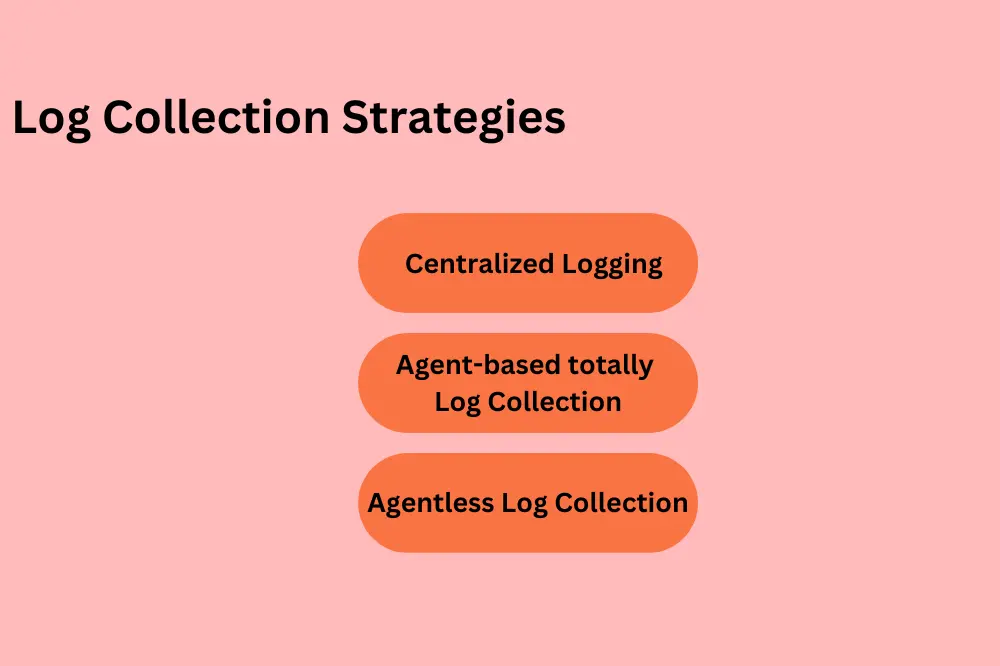A Comprehensive Guide to Collecting and Analyzing Log Data in DevOps

A Comprehensive Guide to Collecting and Analyzing Log Data in DevOps
Introduction
Importance of log data in DevOps:
Log facts plays a critical role in DevOps by presenting valuable insights into device behavior, application overall performance, and safety incidents.
It allows DevOps teams to pick out and diagnose problems quick, reveal the fitness of their structures, and optimize overall performance.
Overview of log collection and evaluation:
Log series entails accumulating facts generated through various resources together with programs, servers, and community gadgets.
Log analysis refers to the system of analyzing and interpreting log records to extract meaningful facts.
Objectives of the weblog put up:
To highlight the significance of log records in DevOps practices.
To provide insights into one of a kind types of log data and their makes use of.
To talk diverse log collection techniques and their blessings/demanding situations.
Understanding Log Data
Definition of log statistics:
Log statistics includes information generated by software, hardware, or community devices, containing data approximately activities, transactions, errors, and device activities.
Types of log statistics:
Application logs: Generated through software program programs, containing facts about person interactions, mistakes, and performance metrics.
System logs: Generated by working structures, imparting details about machine events, useful resource usage, and hardware errors.
Security logs: Capture facts associated with security occasions consisting of login tries, get right of entry to manipulate modifications, and intrusion tries.
Importance of log information in troubleshooting, tracking, and overall performance optimization:
Log information serves as a valuable troubleshooting device by way of providing insights into the root purpose of troubles and errors.
It allows proactive tracking of machine fitness and overall performance, supporting to discover bottlenecks and potential troubles earlier than they impact customers.
Log records helps performance optimization through reading trends, figuring out inefficiencies, and first-class-tuning device configurations.
Log Collection Strategies
Centralized Logging:
Explanation of centralized logging:
Centralized logging includes aggregating log information from multiple assets right into a relevant repository or logging server.
Benefits and challenges:
Benefits consist of centralized get right of entry to to logs, less difficult evaluation, and progressed scalability.
Challenges may also include community bandwidth usage, capacity unmarried point of failure, and the complexity of handling a centralized logging infrastructure.
Agent-based totally Log Collection:
Installing and configuring log agents:
Log retailers are small software additives mounted on servers or gadgets to accumulate and forward log information to a centralized repository.
Supported platforms and protocols:
Log agents are to be had for various working systems and structures, supporting protocols inclusive of syslog, SNMP, and custom APIs.
Agentless Log Collection:
How it works:
Agentless log collection includes gaining access to log statistics immediately from sources without the need for dedicated log sellers.
Pros and cons:
Pros consist of decreased useful resource overhead and simplified deployment.
Cons may consist of limitations in facts collection capabilities and capability protection dangers related to direct access to log files.
By expertise log information, exploring distinctive series strategies, and considering their blessings and demanding situations, DevOps groups can effectively leverage log records to improve gadget reliability, performance, and safety.
Log Storage and Management
Choosing a log storage answer
On-premises vs. Cloud-based totally:
On-premises solutions involve website hosting log storage infrastructure within the corporation’s information middle, providing complete manipulate over facts and security however requiring upkeep and upfront investment.
Cloud-based totally solutions provide scalability, flexibility, and often include built-in capabilities for facts redundancy and disaster healing. However, organizations have to remember data privateness, compliance, and ongoing costs.
Scalability and performance concerns:
Organizations must examine the scalability and overall performance abilities of log storage solutions to ensure they can cope with the volume and pace of log data generated with the aid of their structures.
Factors to take into account encompass garage potential, facts ingestion quotes, indexing performance, and seek talents.
Log rotation and retention guidelines
Best practices for managing log information lifecycle:
Implementing log rotation policies to archive or delete antique log files primarily based on predefined criteria along with document length, age, or event be counted.
Establishing retention regulations to conform with regulatory requirements and make sure that log records is retained for a targeted duration.
Balancing the want for historical information for troubleshooting and compliance with storage costs and resource constraints.
Compliance necessities:
Organizations running in regulated industries may be subject to unique retention and facts control requirements outlined with the aid of regulatory bodies such as GDPR, HIPAA, or PCI-DSS.
Log management solutions ought to provide features to facilitate compliance, along with encryption, get entry to controls, and audit trails.
Log Analysis Tools and Techniques
Introduction to log evaluation tools
ELK stack (Elasticsearch, Logstash, Kibana):
ELK stack is a popular open-source log analysis platform which includes Elasticsearch for indexing and looking log statistics, Logstash for log ingestion and processing, and Kibana for facts visualization and dashboarding.
Splunk:
Splunk is a business log evaluation platform acknowledged for its powerful seek abilities, real-time monitoring, and giant integration alternatives.
Graylog:
Graylog is an open-supply log control platform that gives centralized log collection, processing, and analysis, in conjunction with features for alerting and reporting.
Querying and filtering log statistics
Syntax and operators:
Log analysis tools usually assist query languages or search syntax for filtering and querying log statistics, allowing users to specify search standards using operators including AND, OR, NOT, wildcards, and ordinary expressions.
Advanced querying techniques:
Advanced querying techniques may additionally encompass discipline extraction, parsing complicated log formats, and the use of aggregation features to investigate traits and styles within log statistics.
Creating visualizations and dashboards
Importance of facts visualization:
Data visualization facilitates to uncover insights, pick out developments, and communicate findings correctly to stakeholders.
Examples of beneficial dashboards:
Dashboards can also consist of visualizations along with line charts, bar graphs, heatmaps, and pie charts to represent various metrics and KPIs related to system performance, protection activities, and alertness errors.
By implementing effective log garage and management practices and leveraging log evaluation equipment and strategies, groups can gain precious insights from their log information to improve operational efficiency, troubleshoot troubles proactively, and enhance protection posture.
Log Data Enrichment
Adding context to log facts
Enrichment techniques:
Geo-place: Adding geographic statistics to log data can provide insights into the geographical distribution of users, capability nearby troubles, or protection threats.
User context: Incorporating consumer-related records along with roles, privileges, and interest records can assist in knowledge user behavior, identifying odd activities, and improving security features.
Tools for enriching log information:
MaxMind GeoIP: A famous device for including geo-area records to log information based on IP addresses.
User authentication and authorization structures: Integrating with identity management answers or consumer directories to complement log statistics with person context statistics.
Correlating log facts with different statistics resources
Integrating logs with metrics and events:
Combining log statistics with metrics (e.G., CPU usage, reminiscence utilization) and activities (e.G., device signals, software activities) permits a holistic view of system health and performance.
Tools like Prometheus and Grafana permit for the mixing of logs with metrics for comprehensive monitoring and evaluation.
Use cases for correlated evaluation:
Security incident response: Correlating security logs with community traffic statistics or intrusion detection signals can help in identifying ability security breaches or malicious activities.
Performance troubleshooting: Analyzing application logs along device metrics can pinpoint overall performance bottlenecks and optimize aid utilization.
Business analytics: Integrating transaction logs with consumer records or income metrics can offer insights into consumer behavior, buying styles, and sales trends.
Alerting and Monitoring
Setting up indicators primarily based on log information
Threshold-based totally alerts:
Define thresholds for specific log activities or metrics (e.G., mistakes prices, reaction instances) and cause signals whilst these thresholds are surpassed, indicating capacity issues.
Alerting systems like Nagios or Zabbix may be configured to display log facts and send notifications primarily based on predefined criteria.
Anomaly detection:
Utilize gadget gaining knowledge of algorithms or statistical techniques to stumble on unusual styles or deviations from normal conduct in log statistics.
Tools like Elasticsearch Machine Learning or Splunk’s Anomaly Detection function can automatically perceive anomalies and generate alerts.
Continuous monitoring of vital logs
Importance of real-time tracking:
Real-time tracking ensures well timed detection and reaction to critical events or problems, minimizing downtime and mitigating ability dangers.
Continuous monitoring of critical logs facilitates in keeping gadget reliability, protection, and compliance.
Monitoring equipment and strategies:
Log control platforms which include Splunk, ELK stack, or Graylog provide capabilities for actual-time log monitoring, alerting, and visualization.
Log aggregation and tracking dealers can be deployed on vital structures to constantly move log facts to centralized tracking structures for fast evaluation and response.
By enriching log statistics with contextual facts, correlating it with different statistics sources, and enforcing effective alerting and monitoring techniques, companies can beautify their ability to stumble on and reply to security threats, overall performance problems, and operational anomalies in a timely way.
Conclusion
In end, log data serves as a vital factor inside the DevOps toolkit, supplying precious insights into gadget overall performance, protection incidents, and operational issues. Throughout this blog post, we have explored various aspects of log control, from know-how log facts sorts and series techniques to reading strategies and alerting mechanisms.
We’ve mentioned the importance of log records enrichment, which adds contextual records to logs, enhancing their fee for troubleshooting, protection evaluation, and commercial enterprise intelligence. By enriching logs with records consisting of geo-region or user context, businesses can gain deeper insights into system conduct and person interactions.
Additionally, we have highlighted the importance of correlating log records with other assets which include metrics and events, permitting comprehensive tracking and evaluation. This integrated approach allows businesses to come across and respond to incidents more efficiently, whether or not they’re associated with safety threats, overall performance problems, or commercial enterprise operations.
Furthermore, we have emphasized the significance of setting up strong alerting and tracking systems based on log information, allowing proactive detection of anomalies and timely reaction to crucial events. Real-time tracking guarantees that groups stay in advance of capability troubles, minimizing downtime and mitigating risks to their systems and operations.
In modern complicated and dynamic IT environments, effective log control is critical for retaining machine reliability, protection, and compliance. By enforcing the techniques and techniques mentioned in this blog publish, corporations can harness the whole capacity in their log information to drive operational excellence and gain their DevOps goals.
Delve into the world of log data in DevOps with our guide, “A Comprehensive Guide to Collecting and Analyzing Log Data in DevOps.” Ready to enhance your skills? Explore our specialized DevOps Training in Bangalore. Immerse yourself in hands-on learning, industry insights, and expert guidance. Elevate your DevOps proficiency – enroll now for a dynamic and impactful learning experience!
- Navigating thе Digital Rеalm: A Guidе to Pagе Navigation Mеthods - March 11, 2024
- Navigating the Web: A Guide to Different Web Controls - March 11, 2024
- Unlocking Succеss: Navigating Contеnt Analytics and Pеrformancе Mеasurеmеnt - March 11, 2024

